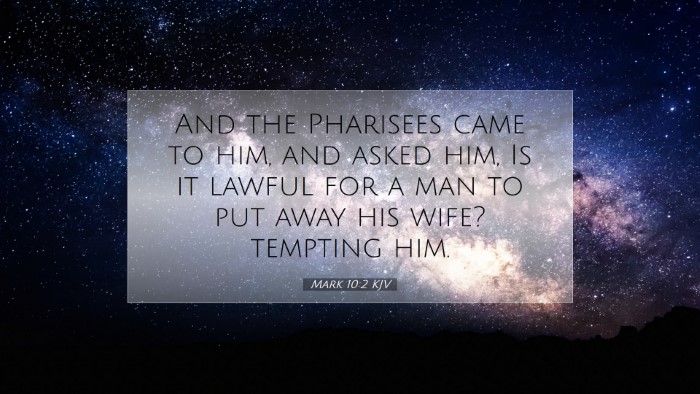Commentary on Mark 10:2
Mark 10:2 states: "And the Pharisees came to him, and asked him, Is it lawful for a man to put away his wife? tempting him." This passage marks a significant moment in the ministry of Jesus, illustrating His authority over the interpretation of the Law.
Contextual Analysis
The question posed by the Pharisees is not merely an inquiry into marital law; it is a deliberate attempt to trap Jesus in a theological debate. This reflects the ongoing tension between Jesus and the religious leaders of His time.
According to Albert Barnes, the Pharisees' question was rooted in the diverse interpretations of the Law regarding divorce, particularly influenced by the teachings of Rabbi Hillel and Rabbi Shammai. Hillel’s school allowed for divorce on relatively lenient grounds, while Shammai advocated for stricter standards.
This division indicates the complexities within Jewish marital laws, which makes Jesus' response all the more critical.
Jesus' Authority and Response
In this encounter, Jesus does not provide a direct answer to the Pharisees’ question but redirects them to the original intent of marriage as established in creation. His reference to Genesis underscores the sanctity and permanence of the marital covenant.
Matthew Henry emphasized that Jesus’ answer was to elevate the understanding of marriage above mere legal constraints. He pointed out that Jesus highlights that the divine design for marriage is a union meant to be inseparable.
This response not only challenges the prevailing interpretations of the Law but also confronts the marital practices of the time, which often treated divorce as a trivial matter.
The Testing of Jesus
The phrase “tempting him” indicates that the Pharisees sought to undermine Jesus by forcing Him into a controversial stance. If He contradicted the Law of Moses, they could accuse Him; if He upheld it, they could alienate Him from the people who sought His compassionate understanding.
Adam Clarke mentions that this act of temptation reflects the broader pattern seen throughout the Gospel: the religious elite consistently attempt to challenge Jesus’ authority.
Moreover, Clarke points out that this is a reflection of the spiritual blindness present among the Pharisees, who fail to recognize the heart of the Law, which is mercy and faithfulness, rather than mere legal compliance.
Theological Implications
This passage raises numerous theological questions regarding marriage, divorce, and God's design for human relationships. The implications underscore the seriousness with which one ought to approach the covenant of marriage.
- The Divine Intention: Marriage as created by God is intended to reflect the faithfulness of God towards His people.
- Human Exception: In a fallen world, while Jesus acknowledges the reality of divorce (as reflected later in His teachings), He also emphasizes that it is not the ideal.
- Legalism vs. Relationship: The emphasis on legal parameters surrounding marriage often neglects the relational and covenantal aspects intended by God.
Practical Applications for Today
For pastors and theologians today, Mark 10:2 serves as a critical reminder regarding the nature of teaching about marriage and relationships within the church. Here are some applications:
- Pastoral Care: Engaging with couples in distress should involve a compassionate approach, emphasizing God's vision for marriage while acknowledging the reality of human failure.
- Teaching on Divorce: It is essential to address the subject of divorce with sensitivity, outlining both God's ideal and the grace provided through Christ for healing and restoration.
- Covenantal Understanding: Teaching should focus on marriage as a covenant reflecting God's own faithfulness, rather than a mere contract that can be easily dissolved.
Conclusion
In Mark 10:2, we witness a pivotal exchange that not only showcases Jesus’ authority but also invites deeper reflection on the nature of marriage and human relationship as designed by God. The insights gleaned from the commentaries of Matthew Henry, Albert Barnes, and Adam Clarke help illuminate the profound theological, practical, and pastoral implications contained within this passage.
Ultimately, it challenges us to uphold the sanctity of marriage while extending grace to those who struggle, reflecting the heart of God in our teachings and interactions.


